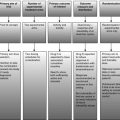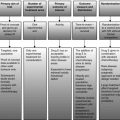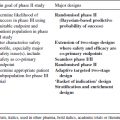8 John Chester and Sarah Brown Drug A is a molecularly-targeted cytostatic agent directed against Epidermal Growth Factor Receptor (EGFR), that was well tolerated as a single agent in phase I trials. It is hypothesised to enhance the efficacy of radiotherapy for patients presenting with locally-advanced head and neck squamous cell carcinoma (HNSCC), for whom current standard treatment is radiotherapy alone. The patient population size is relatively modest, but there are some historical data for treatment with radiotherapy alone, in this population. Data are also available from a patient population with more advanced disease in whom a previous phase III study with a similar molecularly-targeted agent demonstrated efficacy and an acceptable toxicity profile, when used in combination with radiotherapy. A phase II trial of drug A, in combination with radiotherapy as primary treatment, is proposed to be run as an academic study within a large collaborative group. Mechanism of action: Drug A is a molecularly-targeted cytostatic agent directed against EGFR. It is believed to be primarily cytostatic as a single agent, but to act synergistically with radiotherapy. It may therefore have both local radio-sensitising and systemic anti-tumour effects. Aim of treatment: The ultimate aim of primary treatment for patients with locally-advanced disease is cure. Since the combination of drug A with radiotherapy may have both local and systemic anti-tumour effects, achieving radiological complete remission and remaining both locally and systemically disease-free are appropriate indicators of treatment activity. Single or combination therapy: Drug A is given in combination with radiotherapy; therefore, any activity of the combination therapy would need to be greater than that of radiotherapy alone, the current standard treatment. Biomarkers: There are no validated biomarkers associated with drug A or with HNSCC, to allow patient enrichment or surrogate assessment of therapeutic activity. Proof of concept data are available from an earlier phase III study of a similar agent in combination with radiotherapy, in the same tumour type, but in more advanced disease. Combination therapy was shown to be tolerable and achieved improved overall survival (OS) compared to radiotherapy alone in that setting. A proof of concept study for drug A in combination with radiotherapy is therefore not deemed necessary. Rather, the aim of the current trial is to make a go/no-go decision as to whether or not to proceed to a phase III trial of the combination in patients with locally-advanced HNSCC. There is only one experimental treatment under investigation, so a treatment selection trial is not required. Drug A has an acceptable toxicity profile in single-agent studies. Similar agents have been combined safely with radiotherapy in patients with more advanced disease, and therefore the current combination is expected to have only minimal additional toxicity or functional deficit. While toxicity will form a secondary endpoint of the phase II trial, the primary outcome of interest is activity. Since drug A is a putative radio-sensitiser, the primary aim of combination with radiotherapy is to eliminate local disease and minimise disease recurrence. Event-free survival (EFS) is defined as the time from trial registration to first event (i.e. local or distant recurrence or death from any cause) and has been shown to be strongly correlated with OS in patients with locally-advanced HNSCC (Michiels et al. 2009). Patients who do not achieve complete remission are classed as having an event at time zero. A binary outcome measure of being event-free at 8 months post-registration may be assessed to reflect treatment activity on both local and distant disease. This time point corresponds with approximately 3 months after completion of radiotherapy and provides a robust time point at which to assess disease status in the absence of initial post-treatment radiological artefacts. Patients continue to be radiologically assessed every 3 months for the first year after completion of radiotherapy. Therefore this specific time point of interest forms part of the measurement of the overall EFS outcome. These outcome measures, both at 8 months and over the year following completion of radiotherapy, reflect relatively short-term assessments of treatment activity, whereas the primary endpoint of a phase III trial would usually be the longer-term endpoint of OS. Both the binary and overall time-to-event outcome measures are therefore considered as possible primary outcome measures for the phase II trial. The use of a time-to-event endpoint has the potential advantage of providing more information about the pattern of disease recurrence, than simply dichotomising the information at a single time point. However, there are a number of factors contributing to the decision as to which outcome measure to choose as the primary assessment, including available statistical designs, acceptable lengths of follow-up (i.e. follow-up to 8 months only or continued follow-up until event occurrence), randomisation, sample size and design operating characteristic requirements (i.e. type I and II errors). Drug A is to be given in combination with radiotherapy, that is, another effective treatment modality. It is important that any activity observed with the combination may be attributed to the addition of drug A. Randomisation may, therefore, be incorporated to provide a more robust and reliable assessment of the additional benefit derived from the addition of drug A in this particular setting. Incorporating a formal comparison between the arms will ensure decision-making at the end of phase II is more statistically robust. This is particularly relevant here, since the primary aim of the phase II trial is to make a go/no-go decision regarding proceeding to phase III. While this approach may be more appropriate, at this stage we also consider designs that incorporate randomisation without formally powered statistical comparison to address all possibilities in this setting and allow further discussion with the clinicians. It is important that multiple scenarios are considered when choosing the statistical design, to assess how robust each of them is if outcomes in either the experimental or control arm are not as expected. For example, if activity in the control arm is uncertain, how well do the different trial designs cope with an under- or over-estimation of this activity? Rejected designs:
‘Chemo-radio-sensitisation’ in head and neck cancer
Stage 1 – Trial questions
Therapeutic considerations
Primary intention of trial
Number of experimental treatment arms
Primary outcome of interest
Stage 2 – Design components
Outcome measure and distribution
Randomisation
Design category
Stay updated, free articles. Join our Telegram channel

Full access? Get Clinical Tree






